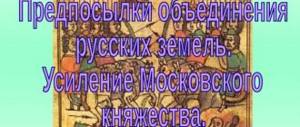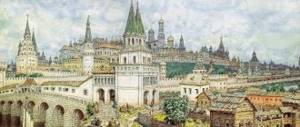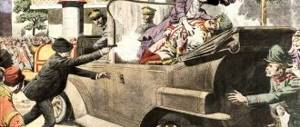Regency of Elena Glinskaya (1533-1538)
Elena Glinskaya was 25 years old in 1533. To govern the country, Vasily 3 left a boyar council, but actual power ended up in the hands of Elena Glinskaya, who mercilessly fought against everyone who could lay claim to power. Her favorite, Prince Ovchina-Obolensky, carried out reprisals against some of the boyars of the council, and the rest no longer resisted Glinskaya’s will.
Realizing that a three-year-old child on the throne is not what the country needs, and that the reign of her son Ivan Vasilyevich the Terrible could be interrupted without actually beginning, Elena decided to eliminate the brothers of Vasily 3 so that there would be no contenders for the throne. Yuri Dmitrovsky was arrested and killed in prison. Andrei Staritsky was accused of treason and executed.
The reign of Elena Glinskaya, as regent of Ivan 4, was quite productive. The country has not lost its power and influence in the international arena, and important reforms have been carried out within the country. In 1535, a monetary reform took place, according to which only the king could mint coins. There were 3 types of money at face value:
- Kopek (it depicted a horseman with a spear, hence the name).
- Money equaled 0.5 kopecks.
- Polushka was equal to 0.25 kopecks.
In 1538, Elena Glinskaya dies. Assume. That it was a natural death is naive. A young and healthy woman dies at 30! Apparently, she was poisoned by boyars who wanted power. Most historians studying the era of Ivan the Terrible agree on this opinion.
Boyar rule (1538-1547)
At the age of 8, Prince Ivan Vasilyevich was left an orphan. Since 1538, Rus' came under the rule of the boyars, who acted as guardians of the young king. Here it is important to understand that the boyars were interested in personal gain, and not the country and not the young king. In 1835-1547 this was a time of brutal massacre for the throne, where the main warring parties were 3 clans: Shuisky, Belsky, Glinsky. The struggle for power was bloody, and all this happened before the eyes of a child. At the same time, there was a complete decomposition of the foundations of statehood and an insane devouring of the budget: the boyars, having received full power into their own hands, and realizing that this would last for 1013 years, began to line their pockets as best they could. Two sayings can best demonstrate what was happening in Rus' at that time: “The treasury is not a wretched widow, you can’t rob her” and “A pocket is dry, so a judge is deaf.”
Ivan 4 was strongly impressed by the elements of boyar cruelty and permissiveness, as well as a sense of his own weakness and limited power. Of course, when the young king received the throne, there was a 180-degree turn in consciousness, and then he tried to prove everything that he was the main person in the country.
Education of Ivan the Terrible
The following factors influenced the upbringing of Ivan the Terrible:
- Early loss of parents. There were also practically no close relatives. Therefore, there really were no people who would strive to give the child the right upbringing.
- The power of the boyars. From his earliest years, Ivan Vasilyevich saw the strength of the boyars, saw their antics, rudeness, drunkenness, struggle for power, and so on. Everything that a child cannot see, he not only saw, but also took part in it.
- Church literature. The archbishop and later metropolitan, Macarius, had a great influence on the future king. Thanks to this man, Ivan 4 studied church literature, fascinated by aspects about the completeness of royal power.
In Ivan's upbringing, the contradictions between word and deed played a big role. For example, all the books and speeches of Macarius spoke about the completeness of royal power, about its divine origin, but in reality, every day the child had to deal with the tyranny of the boyars, who did not even feed him dinner every evening. Or another example. Ivan 4, as a virgin tsar, was always taken to meetings, meetings with ambassadors and other state affairs. There he was treated like a king. The child was seated on the throne, everyone bowed at his feet, talking about admiration for his power. But everything changed as soon as the official part ended and the king returned to his chambers. There were no longer bows, but the harshness of the boyars, their rudeness, sometimes even insulting a child. And such contradictions were everywhere. When a child grows up in an atmosphere where one thing is said and another is done, it breaks all patterns and affects the psyche. This is what ultimately happened, because in such an atmosphere, how can an orphan know what is good and what is bad?
Ivan loved to read and by the age of 10 he could quote many passages from it. He took part in church services, sometimes even participating in them as a singer. He played chess quite well, composed music, knew how to write beautifully, and often used folk sayings in his speech. That is, the child was absolutely talented, and with parental education and love could become a full-fledged person. But in the absence of the latter, and with constant contradictions, the other side began to appear in it. Historians write that at the age of 12, the king threw cats and dogs from the roofs of the towers. At the age of 13, Ivan Vasilyevich the Terrible ordered dogs to tear apart Andrei Shuisky, who, drunk and in dirty clothes, lay on the bed of the late Vasily 3.
Independent rule
Royal wedding
On January 16, 1547, the independent reign of Ivan the Terrible began. The 17-year-old youth was crowned king by Metropolitan Macarius. For the first time, the Grand Duke of Rus' was named Tsar. Therefore, we can say without exaggeration that Ivan 4 is the first Russian Tsar. The coronation took place in the Assumption Cathedral of the Moscow Kremlin. The Monomakh cap was placed on the head of Ivan 4 Vasilyevich. Monomakh's cap and the title “Tsar” Russia becomes the successor to the Byzantine Empire, and the Tsar thereby rose above the rest of his subjects, including the governors. The population perceived the new title as a symbol of unlimited power, since not only the rulers of Byzantium, but also the rulers of the Golden Horde were called kings.
The official title of Ivan the Terrible after the coronation is Tsar and Grand Duke of All Russia .
Immediately after the start of independent rule, the king got married. On February 3, 1947, Ivan the Terrible took Anastasia Zakharyina (Romanova) as his wife. This is an important event, since the Romanovs will soon form a new ruling dynasty, and the basis for this will be Anastasia’s marriage to Ivan on February 3.
The autocrat's first shock
Having received power, without a regency council, Ivan 4 decided that this was the end of his torment, and now he is truly the main person in the country with absolute power over others. The reality was different, and the young man soon realized this. The summer of 1547 turned out to be dry, and on June 21 a strong storm broke out. One of the churches caught fire and, due to strong winds, the fire quickly spread throughout wooden Moscow. The fires continued from June 21-29.
As a result, 80 thousand of the capital's population were left homeless. Popular indignation was directed at the Glinskys, who were accused of witchcraft and starting a fire. When a maddened crowd rose up in Moscow in 1547 and came to the Tsar in the village of Vorobyovo, where the Tsar and the Metropolitan were taking refuge from the fires, Ivan the Terrible for the first time saw the uprising and the strength of the maddened crowd.
Fear came into my soul and trembling into my bones, and my spirit was humbled.
Ivan 4 Vasilievich
Once again, a contradiction occurred - the king was confident in the limitlessness of his power, but he saw the power of nature that caused the fire, the power of the people who rebelled.
State administration system
The governance system of Russia under the reign of Ivan the Terrible should be divided into 2 stages:
- The period after the reforms of the Elected Rada.
- Oprichnina period.
After the reforms, the management system can be graphically depicted as follows.
During the Oprichnina period the system was different.
A unique precedent was created when the state had two control systems at the same time. At the same time, Ivan 4 retained the title of tsar in each of these branches of government of the country.
Lesson “The beginning of the reign of Ivan IV. Reforms of the Elected Rada"
Annex 1
Worksheet on the topic: The beginning of the reign of Ivan IV. Reforms of the Elected Rada
Task 1. Fill in the gaps in the sentences.
Reforms of Elena Glinskaya:
Introduction of a single monetary unit for the entire country -_____________________________________________
A coin appeared_______________________________________________________________________________
In 1534, _________________________________________________________________ was founded in Moscow
They became uniform for the whole country________________________________________________________________
Task 2. Describe the conditions for Ivan IV’s accession to the throne and what influenced the formation of the young tsar’s personality? Describe the personality of the young king. What boyar groups fought for power at the beginning of the reign of Ivan IV ? ______________________________________________________________________________________________________________________________________________________________________________________________________________________________________________________________________________________________________________________________________________________________________________________________________________________________________________________________________________________________________________________________________________________________________________________________________________
Indicate the consequences of the struggle between the boyar clans ________________________________________________________________________________________________________________________________________________________________________________________________________________________________________________________________________________________________________________________________________________________________________________________________________________________________________________________________________________________________
Task 3. When did Ivan’s crowning ceremony take place and where did it take place? __________________________________________________________________________________________________________________________________________________________________________________________
Fill out the diagram
1547
The elected council is ________________________________________________________________________________
_____________________________________________________________________________________________.
Task 4. Fill out the table based on the handouts
| Year | Name of the reform | Contents of the reform |
| 1550 | Judicial reform | |
| 1550 | Central government reform | |
| 1550 | Military reform | |
| 1551 | Church reform | |
| 1556 | Local government reform |
Task 5. Fill out the diagram “Government of the state in the second half of the 16th century”
Supreme ruler
Legislative body Representative body
Executive bodies
| Functions | Functions | Functions | Functions | Functions |
The importance of reforms ______________________________________________________________________________________________
Handout on the topic “The beginning of the reign of Ivan IV. Reforms of the Elected Rada"
"Elena Glinskaya and boyar rule"
In 1533 Vasily III died. Before his death, he appointed a guardianship council of seven influential boyars over his three-year-old son Ivan IV. The Grand Duke ordered the boyars to “take care” of their son and involve him in state affairs. A few days after the death of the Grand Duke, the boyars' guardians crowned Ivan IV. They feared that Ivan III’s brother, appanage prince Yuri, who before the birth of Vasily’s first child would make a claim to power, was considered the heir to the throne. To prevent unrest, they imprisoned Yuri, where three years later he died of starvation.
But soon the widow of Vasily III, Elena Glinskaya, who was burdened by boyar tutelage, took control of the state into her own hands. She brutally dealt with other possible contenders for the Grand Duke's throne - the younger brother of Ivan III, appanage prince Andrei Staritsky. True, the princess did not touch Andrei’s son, Vladimir.
The reign of Elena Glinskaya lasted less than five years. She managed to carry out a number of important reforms that contributed to the centralization of the state. A single monetary unit was introduced for the entire country - the Moscow ruble. A coin appeared, equal to one hundredth of a ruble, with the image of a horseman with a spear, called a kopeck. In 1534, the first state Mint in Russia was founded in Moscow, where coins were produced for the entire state. Units of length and weight became uniform throughout the country.
After the death of the Grand Duchess (in April 1538), a fierce struggle between the boyar families for power began. Poisoning and murder, imprisonment, forced monastic vows became commonplace at the Moscow court. The next group of boyars, which seized power, broke into the palace and, in front of young Ivan’s eyes, despite his pleas for mercy, grabbed and killed close people. All this gave rise to frustration, anger and malice in the heart of the impressionable teenager, and the desire to take revenge on his offenders.
"The Crowning of Ivan IV"
In the 17th year of his life, Ivan announced to Metropolitan Macarius his intention to marry into the kingdom, and not into a great reign, as was customary in Rus'.
The Metropolitan supported this innovation, which promised a significant strengthening of the supreme power. After all, the Horde khans and Byzantine emperors were called tsars in Rus'. And the first Russian Tsar could rightfully claim all those unlimited rights that these rulers enjoyed.
On January 16, 1547, the solemn crowning of Ivan IV took place in the Moscow Assumption Cathedral. The Metropolitan himself placed the Monomakh cap on the Tsar’s head, thereby emphasizing the special position of the Church in the state.
The struggle between the boyar families led to unprecedented abuses, lawlessness and bribery. The situation of large sections of the population has sharply worsened. The cup of patience was filled with a grandiose Moscow fire, which destroyed almost the entire city. In the summer of 1547, popular uprisings broke out in Moscow and then in other cities. It became clear that the country needed reforms aimed at eliminating the consequences of boyar rule and strengthening the central government.
Reforms of the Elected Rada
By this time, a circle of talented people had formed around the young king. It later received the name Chosen Rada - a council of close associates. It was headed by the low-born nobleman Adashev and the priest Sylvester. The elected Rada was supported by the head of the church, Metropolitan Macarius.
The tsar and the elected council carried out a whole series of reforms. The planned transformations were supposed to contribute to the final gathering and unification of all Russian lands around a strong central government, that is, the formation of a centralized state.
In 1549, the first Zemsky Sobor was convened - a meeting of representatives from all classes, except landowner peasants and serfs. Such councils began to be convened from time to time to discuss the most important matters in the state, although there were no rules for their collection and representation; they consisted of the Boyar Duma, representatives of the clergy and feudal lords (later also of the city leaders). It was planned to carry out reforms and draw up a new Code of Laws (the first Code of Laws was under Ivan III). In 1550, a new Code of Law was adopted. He streamlined and supplemented the previous Code of Laws, limited the rights of governors and volosts, and for the first time introduced punishment for bribery.
In 1551, at a church council (called Stoglav), measures were taken to unify the pantheon of saints and rituals, which still bore the imprint of former fragmentation, as well as to “improve” the morals of the clergy. Serious changes affected the central government. Instead of the two previous institutions - the palace and the treasury, which had blurred, intertwined management functions, a whole system of specialized orders was created. Foreign policy was in charge of the Ambassadorial Prikaz, feudal land ownership - the Local Prikaz, state security, the fight against crime - the Robbery Prikaz, military affairs - the Razrydny and Streletsky orders, complaints and control - the Petition Prikaz (it was headed by Adashev), etc.
In the 1950s, the local government system was also reorganized. As a result of the provincial reform (started back in the 30s), cases of “robbery” were removed from the jurisdiction of governors and volosts and transferred to provincial elders, who were elected by the nobles of the district. After 1556, provincial elders became heads of district administrations. The zemstvo reform, carried out mainly in the black sosh districts of the North and in cities, led to the emergence of elected (from among wealthy peasants and townspeople) zemstvo elders, who began to be in charge of the court and the collection of taxes. Finally, in 1556, feedings were abolished. All these measures not only increased the efficiency of management, but also marked the beginning of the formation of an estate-representative monarchy.
Military reforms were important. Military service and the collection of troops, obligatory for feudal lords, were streamlined. Now, for every 150 dessiatines, the feudal lord, under threat of a fine, was obliged to field one mounted armed warrior. Instead of detachments of pishchalniks (which appeared at the beginning of the 16th century), a streltsy army was created; Cossack detachments were used in civil service. Localism was somewhat limited, that is, the procedure for appointment to military and civilian positions based on origin and the precedent established in a given family.
In addition, the monetary system was unified (the ruble became the main national monetary unit) and the system of weights and measures.
A tax reform was carried out (the overall tax burden increased).
Thus, in the middle of the 16th century. In Russia, the largest series of reforms in the entire previous history of the country was carried out (see Table 1). They increased the centralization and efficiency of government and marked the formation of a state apparatus corresponding to the era of the estate-representative monarchy.
Domestic policy
The reign of Ivan the Terrible, in terms of internal governance of the country, is divided into the stage of reforms of the Elected Rada and the oprichnina. Moreover, these systems of governing the country were radically different from each other. The entire work of the Rada boiled down to the fact that power should be with the tsar, but in its implementation he should rely on the boyars. Oprichnina concentrated all power in the hands of the tsar and his system of government, and relegated the boyars to the background.
During the time of Ivan the Terrible, great changes occurred in Russia. The following areas were reformed:
- Ordering the law. Code of Laws of 1550 was adopted.
- Local control. The feeding system was finally abolished, when local boyars lined their pockets rather than solve the problems of the region. As a result, the local nobility gained more power into their own hands, and Moscow gained a more successful tax collection system.
- Central management. A system of “Orders” was implemented, which streamlined power. In total, more than 10 orders were created that covered all areas of the state’s internal policy.
- Army. A regular army was created, the basis of which was archers, gunners and Cossacks.
The desire to strengthen his power, as well as failures in the Livonian War, led to Ivan the Terrible creating the Oprichnina (1565-1572). We can further familiarize ourselves with this topic on our website, but for a general understanding it is important to note that as a result of this, the state actually went bankrupt. An increase in taxes and the development of Siberia began, as steps that could attract additional money to the treasury.
Lesson-judgment, lesson-generalization “Ivan the Terrible - a genius or a villain?”; Grade 10
Target:
- repetition and generalization of knowledge about the era of Ivan the Terrible;
- the ability to evaluate ambiguous historical phenomena and processes;
- development of students’ thinking and speech, discussion skills;
- fostering a negative attitude towards terrorism as a way to solve problems.
Equipment: multimedia computer, slide presentation, historical map “Russia of the 16th century”, memo “Characteristics of a historical figure”.
The epigraph for this lesson can be taken from the words of V. O. Klyuchevsky: “He can be compared with that Old Testament blind hero who, in order to destroy his enemies, knocked down the building on whose roof these enemies were sitting on top of himself.”
Preliminary preparation. Students receive a lesson plan in advance, a list of references (works by V. O. Klyuchevsky, N. M. Karamzin, A. A. Zimin, correspondence between A. Kurbsky and Ivan the Terrible), decide on the position of the defense or prosecution, prepare key questions according to a given plan , consult with the teacher.
I consider it inappropriate to stage a discussion in advance during a lesson, since this form of lesson involves independent creative work by students, during which they show the ability to use historical knowledge and facts, evaluate them, express and defend their own opinions.
Lesson plan:
1) Ivan the Terrible - tyrant or reformer,
Oprichnina and its consequences,
Foreign policy
Results of the reign of Ivan the Terrible
Teacher. Today we have a lesson in repetition and generalization in the form of a trial. Let's check whether the prosecution and defense are present. Please take your seats. Get up! The trial is coming! I ask everyone to sit down. Please introduce us to the prosecution witnesses A. Adashev, Sylvester, Prince. Kurbsky, M. Nagaya. Witnesses for the defense: M. Skuratov, A. Romanova, Ermak. (these historical figures can be played by the students themselves, or they can simply be told by the defense and prosecution, relying on certain historical sources).
Witnesses for the prosecution will be Alexey Adashev, Sylvester, Prince Kurbsky, Marina Nagaya. Witnesses for the defense: Malyuta Skuratov, Anastasia Romanova, Ermak. The experts in this process are the famous Russian historian S. M. Solovyov and the outstanding Russian psychiatrist, Professor P. I. Kovalevsky.
Judge. The prosecution has the floor.
Representative of the prosecution (hereinafter the text of the statements is approximate, since it must be formulated by the student on the basis of his preliminary work). Dear Court! Today we have to make our verdict on whether Ivan the Terrible was a genius or a villain.
The prosecution intends to prove to you that being a despot by nature, a godless and cruel man, overwhelmed by a thirst for personal rule, the defendant gave orders to kill his subjects, who served him with faith and truth. He limited and violated established traditions and orders for centuries, leaving the country in a state of ruin by the end of his reign. Such a person cannot be a genius. In a word - a tyrant.
Judge. The defense side has the floor.
Protection. We intend to refute the above. We will prove to you that the actions of the accused were a consequence of his difficult character, which was formed in difficult living conditions.
Having accepted the country in an unstable state, when the boyars, busy with the struggle for power, did not particularly burden themselves with state affairs, Tsar Ivan Vasilyevich left to his descendants a strong Russia, completely independent of the Horde and significantly expanding its territory.
Judge. We invite Ivan himself to tell you what you can say about the accusation.
Ivan. He tells his biography, lists his reforms and their results.
A discussion begins between the defense and prosecution. Witnesses of one side or another are invited.
Teacher. What conclusion can we draw from all of the above? There is a general discussion. The board reads: “In Russian history, perhaps, there is no other person who would cause more controversy among researchers. Some consider him a monstrous tyrant, others - a progressive statesman. A reformer who became a tyrant on the grief of the entire country, the entire people, having achieved unlimited power.”
Judge. The next charge is oprichnina.
Prosecution. The policy of the oprichnina led to the economic ruin of the country, the process of enslavement of the peasants and the extermination of their own people began.
Teacher. What can the defense say on this issue?
Defense side. This policy was aimed at strengthening the personal power of the king and eliminating the remnants of the appanage system.
A discussion begins between the defense and prosecution. Witnesses of one side or another are invited.
Teacher. What conclusion were we able to come to regarding the second count of the accusation? After discussion, the conclusion is displayed:
“The policy of the oprichnina contributed to centralization, eliminated the consequences of feudal fragmentation, and established the regime of personal power of Ivan the Terrible. But the consequences of the oprichnina include: an economic crisis, the establishment of serfdom, a weakening of foreign policy positions, a weakening of the military power of the state, and also a direct consequence of the oprichnina - the Troubles.”
Judge. We are ready to hear the prosecution on the next point.
Prosecution. Ivan the Terrible is accused of ceding Livonia and Polotsk to Poland; gave Yam, Koporye, Ivangorod, Narva to Sweden. The Livonian War led the country into decline and the impoverishment of the Russian people.
Judge. What can the defense say in favor of its client?
Defense side. Without denying the above, he asks you to look at the map of the 16th century, where you can see which territories were annexed to Russia by Ivan the Terrible and asks to compare the size of the acquired and lost lands.
A discussion begins between the defense and prosecution. Witnesses of one side or another are invited.
Teacher. I propose to discuss the conclusion on this charge. The output is displayed:
“The annexation of Kazan, Astrakhan, and the beginning of the development of Western Siberia overshadowed the defeat in the Livonian War, which dealt a crushing blow to the state’s economy and became a catalyst for the Time of Troubles.”
Judge. Thank you, all parties spoke today, all witnesses were interviewed. Let's move on to the main question of our trial: genius or villain?
A discussion begins between the defense and prosecution. Witnesses of one side or another are invited.
Teacher. So what result have we come to today?
Ivan Vasilyevich is undoubtedly a contradictory personality, great and terrible at the same time.
He, as a brilliant politician, managed to strengthen centralized power, unite the country, expand its territories, but these were the methods and means of a villain. No great goals can justify terror against one's own people. Full text of the material Lesson-trial, lesson-summarization “Ivan the Terrible - a genius or a villain?”;
For grade 10, see the downloadable file . The page contains a fragment.
| Author: Pirogova Natalya Vyacheslavovna → Pirogova1026 08/15/2015 0 10259 970 | Comment |
Thank you for your mark. If you want your name to be known to the author, log in to the site as a user and click Thank you again. Your name will appear on this page.
Login | Registration
Have an opinion? Leave a comment
Foreign policy
By the beginning of the independent reign of Ivan 4, Russia had significantly lost its political status, since 11 years of boyar rule, when they cared not about the country, but about their own wallet, had an effect.
The table below shows the main directions of Ivan the Terrible’s foreign policy and the key tasks in each direction. Russian foreign policy under the reign of Ivan the Terrible
| Protection from attacks by the Crimean Khanate | Return of ancient Russian lands and access to the Baltic Sea. | security of the country's eastern borders. Capture of the Volga trade routes. Solving the problem of Astrakhan and Kazan. |
East direction
Here maximum success was achieved, although everything did not start out in the best way. In 1547 and 1549, military campaigns against Kazan were organized. Both of these campaigns ended unsuccessfully. But in 1552 the city managed to take it. In 1556, the Astrakhan Khanate was annexed, and in 1581 Ermak’s campaign to Siberia began.
South direction
Campaigns were undertaken to the Crimea, but they were unsuccessful. The largest campaign took place in 1559. Proof that the campaigns were unsuccessful is that in 1771 and 1572 the Crimean Khanate carried out raids on the young territories of Russia.
Western direction
To solve problems on the western borders of Russia in 1558, Ivan the Terrible begins the Livonian War. Until a certain time, it seemed that they could end in success, but the first local failures in the war broke the Russian Tsar. Blaming everyone around for the defeats, he started the Oprichnina, which actually ruined the country and made it incapable of fighting. As a result of the war:
- In 1582, peace was signed with Poland. Russia lost Livonia and Polotsk.
- In 1583, peace was signed with Sweden. Russia lost the cities: Narva, Yam, Ivangorod and Koporye.
Russia in the 16th century Ivan groznyj
“To hunt hares, you need many dogs; to defeat enemies, you need many warriors.” Ivan IV.
During the lesson, you will learn about boyar rule in Russia, the beginning of the reign of Ivan IV, the oprichnina, the foreign policy of Ivan the Terrible, and the reign of Tsar Fedor.
Boyar rule. In 1533 Vasily III died. According to his will, the throne passed to three-year-old Ivan IV. But before the heir came of age, real power had to be in other hands.
Before his death, Vasily III assembled a “guardian council”, which included representatives of the boyar clans. They were supposed to protect Ivan until he turned 15 years old.
However, Vasily III's wife Elena Glinskaya, with the help of Ivan Obolensky, eliminated the guardians and gained power.
During the five years of Elena Glinskaya's reign, a single coin was introduced in the state; the privileges of the aristocracy are limited.
In 1538, Elena Glinskaya died, there were rumors that she was poisoned. The boyars began to share power. From 1538 to 1547, the period of boyar rule continued. At this time, the activities of the state apparatus were stopped, as there was a constant struggle for power between the clans.
While the boyars argued among themselves, the little heir to the throne was left to his own devices. It was then that such traits as suspicion and cruelty appeared in him. No one was in a hurry to explain to Ivan how the Russian state works.
Beginning of the reign of Ivan IV. Ivan IV reached the age of 15 in 1545 and became a full-fledged ruler. On the advice of Metropolitan Macarius, he accepted the royal title, which significantly elevated his position in the eyes of other states.
On January 16, 1547, the crowning ceremony of Ivan IV took place in the Assumption Cathedral.
In the summer of 1547, a terrible fire occurred in Moscow, which claimed many lives. Ordinary people began to blame the Glinskys for what happened, for whom they did not have much love. An uprising began in Moscow, during which Yuri Glinsky was killed right on Cathedral Square. Family estates were looted. All this time, Ivan IV was hiding in his royal residence in the village of Vorobyovo.
The events of the uprising frightened the young ruler. Ivan decided that he needed advisers who could explain the mechanisms of government and warn against mistakes.
In 1549, the Elected Rada began its work, which included Metropolitan Macarius, Alexei Adashev, the Tsar’s confessor Sylvester, Prince Andrei Kurbsky and others.
The reign of Ivan IV with the Elected Rada was considered by many to be the best period of his reign. Reforms were implemented that solved 4 main problems.
The first is the limitation of the privileges of the aristocracy. Ivan IV eliminated the “feeding” system, which gave the governors the opportunity for arbitrariness. Tarkhans, tax benefits for large feudal lords, were also revised.
In Russia there was a system of localism. It provided for a person to receive a position in accordance with the ranks of his ancestors. Now, during wartime, localism was abolished, and governors were appointed taking into account their abilities.
The second task was to strengthen the military-police apparatus, which was supposed to become the support of the monarchy. The “chosen thousand” nobles were given estates around Moscow. This thousand included the most loyal mounted warriors to the king.
Another support of Ivan IV were the Streltsy - townspeople who entered military service and received a salary for this. The archers wore a special uniform and obeyed the requirements of military discipline.
In peacetime, they guarded the Kremlin and the Tsar's palace and suppressed popular unrest. The archers were also allowed to engage in trade and craft in their free time.
The third task is to strengthen the material and financial base. The basis of wealth at that time was land, so it was important to return everything that was stolen under boyar rule. The elected council focused its attention on church lands. A decree was issued on the return of all lands transferred to the monasteries.
The growth of monastic land ownership and abuse of the clergy prompted the tsar to criticize the church at the Council of the Stoglavy in 1551. It unified rituals, established iconographic canons, and banned usury among priests.
To find out the true size of the land fund, the Chosen One began to compile new scribe books. A unified land taxation was also established, which was called the “big plow”.
The fourth task was to improve the management apparatus. The number of orders grew, their role became more significant.
An important step towards centralizing the management system was the Code of Laws of 1550.
Oprichnina. In 1560, Ivan IV and the Elected Rada came into conflict. The reason was the disagreement between the tsar and Alexei Adashev regarding foreign policy. But the real reason can be called the desire of Ivan IV to rule alone.
As a result, Adashev and Sylvester lost their seats in the Rada. Kurbsky was exiled to Livonia. And Metropolitan Macarius was too old to fight the king.
The Boyar Duma also stood in the way of Ivan IV. The king had to coordinate all decisions with her. Then the main means of combating the dissatisfied aristocracy became executions. Members of the Boyar Duma were intimidated and did not contradict the Tsar. The period from 1560 to 1584 became the time of the dictatorship of Ivan IV, who wanted to achieve absolute obedience of the ruling class.
The apotheosis of the dictatorship of Ivan the Terrible was the oprichnina. The king was pushed to create it;
aggravation of contradictions with the highest nobility;
failures of the Russian army in the Livonian War;
fear of a boyar conspiracy.
At the end of 1564, Ivan the Terrible left for Aleksandrovskaya Sloboda, taking with him the treasury and symbols of power. From there he informed the boyars that he was abdicating the throne.
The tsar also sent a letter to the townspeople, in which he complained about the betrayal of the boyars and assured the townspeople of his disposition. Thousands of angry Muscovites gathered near the Kremlin. The Boyar Duma was taken by surprise and sent its representatives to the settlement, who begged for forgiveness. Ivan the Terrible said that he would return only if the Duma accepted his conditions, under which he could:
execute traitors;
to impose disgrace;
deprive of property.
Another condition of Ivan the Terrible was the introduction of the oprichnina. The country was divided into two parts - the oprichnina and the zemshchina, each of them had its own government.
The zemshchina was led by the boyars, and the oprichnina was led by the tsar himself. The center of the oprichnina became Alexandrovskaya Sloboda. For his protection, Ivan IV created a special corps of guardsmen, numbering about 6 thousand people. It included nobles who had to carry out any order of the king. The main condition for the guardsmen was the absence of any connections with the zemstvo people.
The Tsar's guardsmen wore black clothes with wide belts. They attached a broom to the saddle of their horses, and hung a dog's head on the horse's neck. This symbolized the readiness to sweep out any treason from the state and cut off the heads of traitors.
The oprichnina system had two goals. The first is the undermining of the economic power of large aristocrats. It was implemented through the resettlement policy. The fact is that the oprichnina included rich cities and counties in which the estates of the Rostov-Suzdal nobility were located. These lands were assigned to the tsar and became the estates of the guardsmen. Former land owners were sent to the zemshchina. In addition, the settlers did not have the right to take property and valuables with them.
The second goal of the oprichnina was the physical destruction of the most prominent representatives of the aristocracy. It was achieved through terror. The guardsmen grabbed people who were disliked by the tsar and took them to Alexandrovskaya Sloboda. There, after much torture, they were killed.
The state plunged into chaos, people lived in constant fear. Metropolitan Philip Kolychev openly opposed the oprichnina, for which he later paid with his life.
The largest massacre of Ivan the Terrible was the campaign against Novgorod, committed in 1570. The king suspected the city residents of treason and decided to take revenge on them. According to historians, about 10 thousand people died during the Novgorod events.
In 1572, the oprichnina was officially abolished. However, in reality it simply received a different name. In 1575, Simeon Bekbulatovich was installed at the head of the zemshchina, who was crowned king. And Ivan IV declared himself the Prince of Moscow. Ivan the Terrible called his possessions “the yard.” The bloody terror continued there, the victim of which could have been absolutely anyone.
In addition to the oprichnina, famine and plague struck the state, and the Livonian War was going on. People accumulated hatred towards Ivan the Terrible, which was later reflected in the events of the Time of Troubles.
Let's consider the foreign policy of Ivan IV.
Onslaught to the East. Russia fought against the Siberian, Crimean, Astrakhan and Kazan khanates, as well as the Nagai Horde.
Ivan III also ensured that in the Kazan Khanate there were people on the throne who were peacefully disposed towards Moscow. But in the middle of the 16th century the situation changed. At this time, there was a threat of unification of the Crimean Khanate with Kazan.
Ivan IV undertook three campaigns against Kazan. The first two in 1547-1548 and in 1550 did not bring success. Then in 1551, not far from Kazan, the Sviyazhsk fortress was built, which became the support of the army in the third campaign. As a result, Kazan fell on October 2, 1552.
The opportunity opened up for Ivan IV to take possession of the entire Volga. The Astrakhan Khanate was an obstacle in this matter. In the summer of 1556, the Russian army moved into these lands. Astrakhan surrendered without a fight, and the khan fled to Turkey.
At the end of his reign, Ivan IV began to fight the Siberian Khanate. The first on this path was Ataman Ermak Timofeevich. He and a detachment of 500 people defeated the army of Khan Kuchum and captured Kashlyk. After the death of Ermak, new forces came to replace him. The development of Western Siberia continued over the following years.
Livonian War. Ivan IV decided to fight the Baltic states. In 1558, he sent his troops there. The Russian army won a number of victories in Livonia. But Alexey Adashev persuaded the tsar to conclude a truce with the Livonians, since he believed that it was better to pay attention to the eastern direction of foreign policy. At this time, the Livonian Order turned to the King of Poland and Lithuania, Sigismund II, for help and enlisted his support.
In the spring of 1560, Ivan IV again launched an attack on Livonia. After the Russian victory at Ermes and the capture of Fellin, the Livonian Order began to disintegrate. Sweden entered the fight for his inheritance. And in the fall of 1561, the lands of the Order were declared the possession of Poland and Lithuania.
In the course of a complex diplomatic game, Ivan IV concluded a truce with Sweden. At the first stage of the fight against Lithuania, he won a number of major victories, but then the Russian army began to suffer defeats. In addition, the king was distracted by problems within the state.
In 1569, Poland and Lithuania united to form the Polish-Lithuanian Commonwealth. The troops of King Stefan Batory approached Pskov. Convinced of the inaccessibility of the city, Batory began negotiations, during which the Peace of Yam-Zapolsky was concluded in 1582. According to him, both states returned to their pre-war borders.
In 1583, the Treaty of Plus was concluded with Sweden.
Tsar Fedor and Boris Godunov. After the death of Ivan the Terrible, his son Fedor became king. Under him, a “guardian council” was created, but the boyars quickly quarreled among themselves and did not provide assistance to the young ruler.
At this time, the rise of Boris Godunov, who was the brother of the Tsar's wife, began. Godunov became the most influential person in the state; no important decisions were made without his advice.
Boris Godunov tried in every possible way to strengthen his position, relying on the support of different classes. The concession to the nobles was not the restoration of St. George's Day and the introduction in 1597 of a five-year period for searching for fugitive peasants. Fedor did this at the suggestion of Godunov.
In 1589, church reform was carried out. The Metropolitan of Moscow began to be called the Patriarch. And some bishops received the rank of metropolitans and archbishops. With this, Boris Godunov won the favor of the clergy.
Merchants and artisans were interested in a strong central government. Therefore, Godunov contributed to the construction of new cities and the improvement of old ones.
The situation with the large aristocracy was difficult. There were frequent cases when representatives of noble families were executed or sent into exile.
In 1591, the youngest son of Ivan the Terrible, Dmitry, who was in Uglich, died. The Tsarevich's mother blamed the death of her son on people allegedly sent by Boris Godunov. She argued that Godunov was clearing his way to the royal throne.
In 1598, Fedor died without leaving an heir. He became the last ruler from the Rurik dynasty.
A Zemsky Sobor was convened in Moscow, which elected Boris Godunov as the new Tsar.
Let's summarize:
From 1538 to 1547, the period of boyar rule continued in Russia.
In 1547, Ivan IV was crowned king.
The oprichnina period lasted from 1565 to 1572.
In 1552, Ivan IV conquered the Kazan Khanate, and in 1556 - the Astrakhan Khanate.
The Livonian War lasted from 1558 to 1583.
In 1598, the last ruler of the Rurik dynasty, Tsar Fedor, died.







